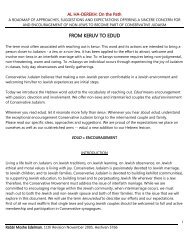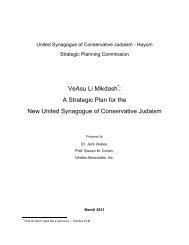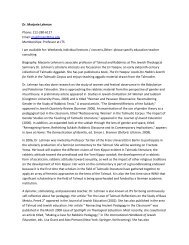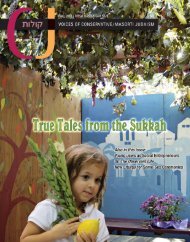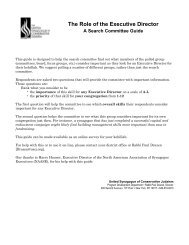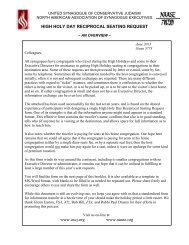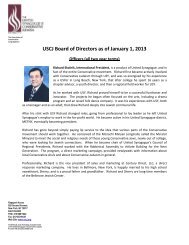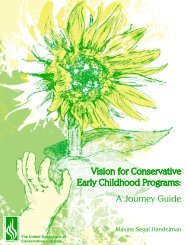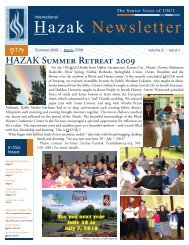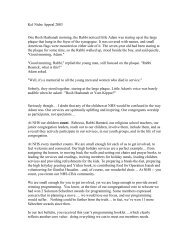2007 - United Synagogue of Conservative Judaism
2007 - United Synagogue of Conservative Judaism
2007 - United Synagogue of Conservative Judaism
You also want an ePaper? Increase the reach of your titles
YUMPU automatically turns print PDFs into web optimized ePapers that Google loves.
members participate. This year we decided that to increase member participation we would promote different projects<br />
throughout the year and thus was born the idea for “Every Day is Mitzvah Day.”<br />
The intent <strong>of</strong> this project, begun in the fall <strong>of</strong> 2006, was to document the community service mitzvot our<br />
members perform throughout the year, hoping to reach and surpass our goal <strong>of</strong> 613 reported mitzvot before May <strong>2007</strong>.<br />
Two <strong>of</strong> our members collaborated to make a beautiful indicator “Tree <strong>of</strong> Mitzvot” to enable us to publicly track our<br />
progress towards our goal.<br />
We put together a brochure <strong>of</strong> Mitzvah opportunities including projects our JCCP committee sponsored as well<br />
as other community service projects in Bergen County. We highlighted UJA Federation projects such as Kosher Meals<br />
on Wheels, Bergen Reads (a literacy volunteer program) and Shalom Baby. We publicized our activities in our monthly<br />
Bulletin and via congregational emails, and designed a mitzvah reporting form. We enabled people to report via mail, as<br />
well as via email. A “Volunteer Appreciation” Celebratory Brunch will be held in May, featuring entertainment and<br />
special foods, will provide an opportunity to recognize all those who participated.<br />
HONORABLE MENTION<br />
CONGREGATION BETH ISRAEL<br />
250-500 Scotch Plains, NJ<br />
Submittted by Laurie Woog 908-889-5523<br />
This application focuses on the signature project <strong>of</strong> the Beth Israel’s Social Action committee: the “Homeless Project.”<br />
Last summer, we initiated an annual effort to provide temporary shelter at the synagogue to area families, women and<br />
children who had nowhere else to stay.<br />
First, the application describes the evolution <strong>of</strong> our congregation’s Social Action Committee and our<br />
introduction to the Homeless Project. Next, the application describes the organization and structure <strong>of</strong> our synagogue’s<br />
Social Action committee.<br />
Next, we highlight the support that Beth Israel’s congregants give to the social action committee. The<br />
synagogue sponsors many different groups whose activities complement those <strong>of</strong> the committee; also, congregation<br />
members directly support the goals <strong>of</strong> the Social Action committee by donating funds and goods for various causes;<br />
providing volunteers to lead Shabbat services for nursing home residents; participating in talent shows at an assisted<br />
living facility; and delivering food to a local food pantry. Most notably, congregation members enthusiastically<br />
volunteered their time during the year and over the summer to help with the Homeless Project.<br />
Another component <strong>of</strong> the application describes how our committee has worked with other community groups<br />
in order to become a host congregation for the Homeless Project; we worked most closely with the Interfaith Hospitality<br />
Network (the “Network”) to help address the needs <strong>of</strong> the temporarily homeless population <strong>of</strong> Union County, New<br />
Jersey. This component <strong>of</strong> the application also addresses how our committee worked with other religious groups and<br />
with area businesses.<br />
The next section <strong>of</strong> the application addresses the way in which the Social Action Committee’s Homeless<br />
project involved the rest <strong>of</strong> the congregation. Over 100 people helped with this project in some manner, whether it was<br />
greeting guests, playing with their kids, making food, serving meals, driving to showers or activities, sleeping over, or<br />
donating the cost <strong>of</strong> a meal. The following section describes the involvement and utilization <strong>of</strong> the skills <strong>of</strong> our<br />
synagogue pr<strong>of</strong>essionals, particularly the rabbi and executive director.<br />
Our synagogue approached the problem <strong>of</strong> homelessness in our community by adhering to a program<br />
developed by a particular organization, but it was unique because we had to maintain kashrut and other ritual standards.<br />
Our congregation hopes that other congregations can use our methods as a model for hosting in the future.<br />
The last part <strong>of</strong> the application describes the impact <strong>of</strong> the Homeless on the synagogue in particular, and the response<br />
from the community in general. Our committee believes that this project had a large and positive effect on our<br />
synagogue, detailed in the application. It also made the community aware <strong>of</strong> the efforts <strong>of</strong> our synagogue, and <strong>of</strong> the<br />
Interfaith Hospitality Network’s ongoing need for support.



